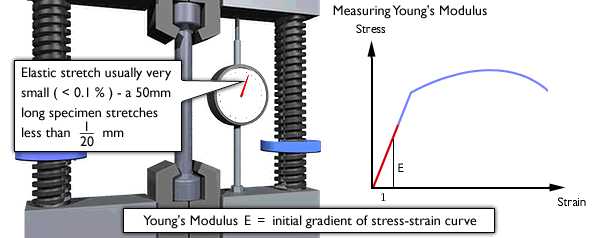Property Information
Young's Modulus and Specific Stiffness
Overview
- Young's modulus measures the resistance of a material to elastic (recoverable) deformation under load.
- A stiff material has a high Young's modulus and changes its shape only slightly under elastic loads (e.g. diamond). A flexible material has a low Young's modulus and changes its shape considerably (e.g. rubbers).
- A stiff material requires high loads to elastically deform it - not to be confused with a strong material, which requires high loads to permanently deform (or break) it.
- The stiffness of a component means how much it deflects under a given load. This depends on the Young's modulus of the material, but also on how it is loaded (tension, or bending) and the shape and size of the component.
- Specific stiffness is Young's modulus divided by density (but should more properly be called "specific modulus").
Design issues
- Stiffness is important in designing products which can only be allowed to deflect by a certain amount (e.g. bridges, bicycles, furniture).
- Stiffness is important in springs, which store elastics energy (e.g. vaulting poles, bungee ropes).
- In transport applications (e.g. aircraft, racing bicycles) stiffness is required at minimum weight. In these cases materials with a large specific stiffness are best.
Measurement
Tensile testing is used to find many important material properties. The compression test is similar but uses a stocky specimen to prevent bending.

Units & Values
Young's modulus is equal to elastic stress/strain. Strain has no units to the units are the same as stress: N/m2, or Pascals (1 Pa = 1N/m2 ; 1 GPa = 1000 N/mm2
Specific stiffness (more properly called specific modulus) is Young's modulus/density - it is mostly used for comparing materials so the units are not important.



